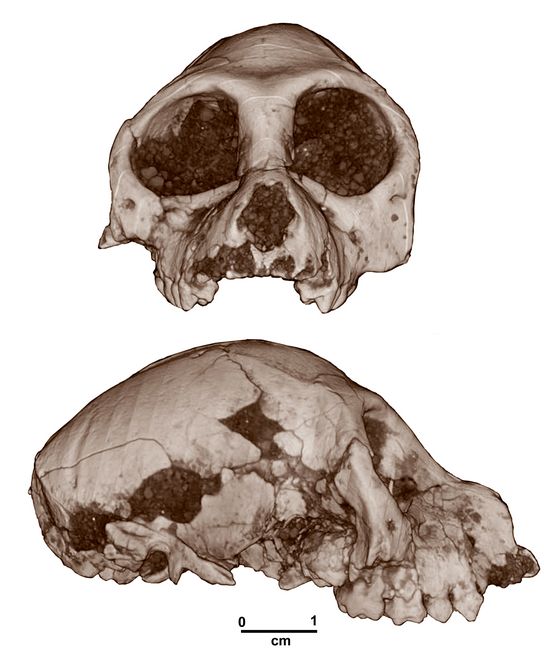Athena Review Image Archive ™
Aegyptopithecus zeuxis female skull

Female Skull of Aegyptopithecus zeuxis (Simons et al. 2007)
Aegyptopithecus zeuxis was a stem catahrrine (early anthropoid) species found in the Jebel Qatrani Formation in the Egyptian Fayum Depression, dating from the Early Oligocene period at 30-29 mya. This Formation has yielded a multitude of Eocene and Oligocene primate fossils, placed in 26 species, 19 genera, and 10 families including bothprosimians and anthropoids. While a number of Aegyptopithecus and other Propliopithecine skull portions had been previously found, the most complete (and smallest) skull yet known was that of a sub-adult female found in 2004 [Egyptian Geological Museum, Cairo (CGM) 85785; the frontal and right lateral views are shown in the figure].
Precise measurement of this skull shows that Aegyptopithecus had relatively unexpanded frontal lobes, and a lower brain-to-body mass ratio than those of living anthropoids. The endocranial volume for CGM 85785, at 14.63 cm3, falls well below previous estimates for A. zeuxis, which had ranged between 30 cm3 for male skulls and 27 cm3 for female skulls. Revised measurements of a male skull (CGM 40237) for endocranial volume by using high-resolution CT scans has yielded a volume of between 20.5 and 21.8 cm3.
A significant degree of sexual dimorphism is also indicated in skull size, with the skull of CGM 85785 only 70% the size of a male A. zeuxis skull (CGM 40237), and the latter is even smaller than some other male A. zeuxis crania. Overall, A. zeuxis was highly sexually dimorphic in postcanine tooth size, craniofacial morphology, brain size, and body mass. This is the earliest known example of a peculiar pattern otherwise known only from the fossil record of Miocene catarrhine evolution.
Major differences in the size of male and female Aegyptopithecus
led to striking differences in craniofacial morphology. Female crania
lacked a well developed rostrum, an elongate sagittal crest, and
steep frontal bones. Notably, early and middle Miocene males including Afropithecus turkanensis and Victoriapithecus
macinessi have those features, whereas female specimens such as Proconsul heseloni and Turkanapithecus kalakolensis do not. As Simons et al. (2007) state, further comparisons of craniofacial sexual dimorphism differences with the earlier Aegyptopithecus and other Propliopithecoid taxa should help clarify the phylogenetic relations of these Miocene anthropoids.
References:
Elwyn
L. Simons, E.L., E.R.. Seiffert, T.M. Ryan, and Y.Attia
2007. A remarkable female cranium of the early Oligocene
anthropoid Aegyptopithecus zeuxis (Catarrhini, Propliopithecidae). Proc.Nat.Acad.Sci. 104, no. 21, pp.8731-8736.
.Copyright © 1996-2020 Rust Family Foundation (All Rights Reserved).